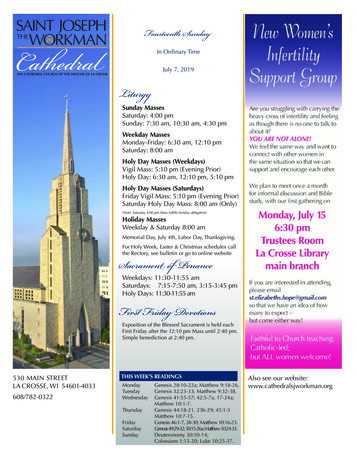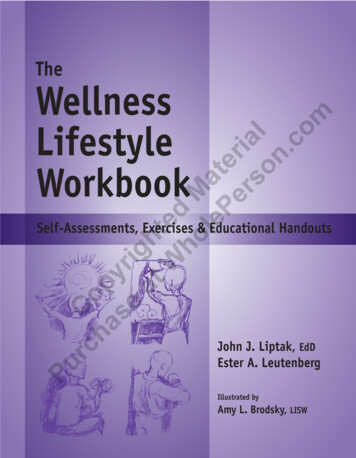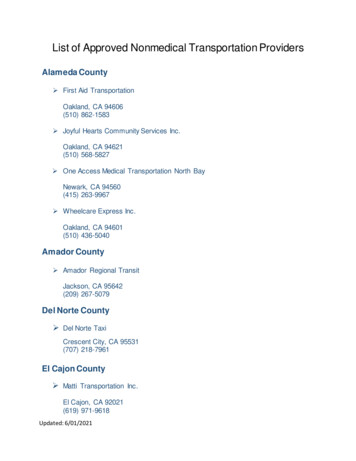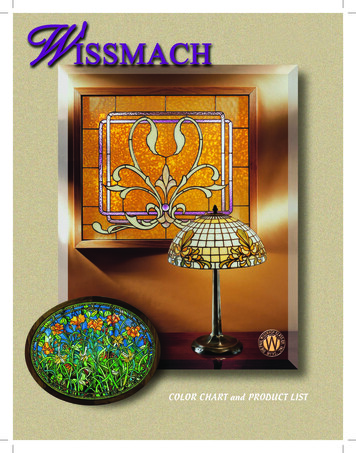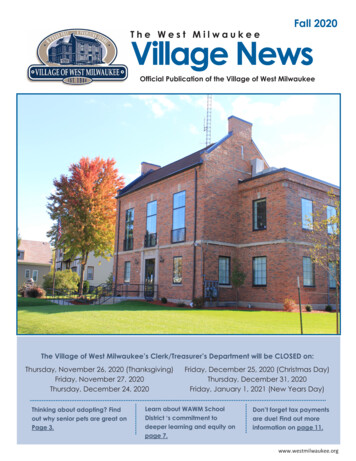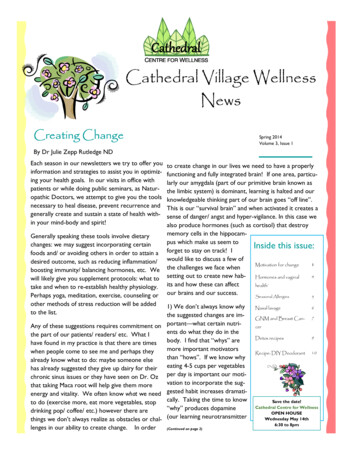
Transcription
Cathedral Village WellnessNewsCreating ChangeSpring 2014Volume 3, Issue 1By Dr Julie Zepp Rutledge NDEach season in our newsletters we try to offer youinformation and strategies to assist you in optimizing your health goals. In our visits in office withpatients or while doing public seminars, as Naturopathic Doctors, we attempt to give you the toolsnecessary to heal disease, prevent recurrence andgenerally create and sustain a state of health within your mind-body and spirit!Generally speaking these tools involve dietarychanges: we may suggest incorporating certainfoods and/ or avoiding others in order to attain adesired outcome, such as reducing inflammation/boosting immunity/ balancing hormones, etc. Wewill likely give you supplement protocols: what totake and when to re-establish healthy physiology.Perhaps yoga, meditation, exercise, counseling orother methods of stress reduction will be addedto the list.to create change in our lives we need to have a properlyfunctioning and fully integrated brain! If one area, particularly our amygdala (part of our primitive brain known asthe limbic system) is dominant, learning is halted and ourknowledgeable thinking part of our brain goes “off line”.This is our “survival brain” and when activated it creates asense of danger/ angst and hyper-vigilance. In this case wealso produce hormones (such as cortisol) that destroymemory cells in the hippocampus which make us seem toInside this issue:forget to stay on track! Iwould like to discuss a few of1Motivation for changethe challenges we face whensetting out to create new hab- Hormones and vaginal4its and how these can affecthealth our brains and our success.Seasonal Allergies1) We don’t always know whythe suggested changes are imAny of these suggestions requires commitment on portant—what certain nutrients do what they do in thethe part of our patients/ readers/ etc. What Ibody. I find that “whys” arehave found in my practice is that there are timesmore important motivatorswhen people come to see me and perhaps theythan “hows”. If we know whyalready know what to do: maybe someone elsehas already suggested they give up dairy for their eating 4-5 cups per vegetableschronic sinus issues or they have seen on Dr. Oz per day is important our motivation to incorporate the sugthat taking Maca root will help give them moreenergy and vitality. We often know what we need gested habit increases dramatically. Taking the time to knowto do (exercise more, eat more vegetables, stop“why” produces dopaminedrinking pop/ coffee/ etc.) however there arethings we don’t always realize as obstacles or chal- (our learning neurotransmitterlenges in our ability to create change. In order(Continued on page 2)5Nasal lavage6GNM and Breast Can-7cerDetox recipes9Recipe: DIY Deodorant10Save the date!Cathedral Centre for WellnessOPEN HOUSEWednesday May 14th6:30 to 8pm
Motivating Change Continuedwant to. These are allYou have to care about yourself before you can really carestress/ danger signals thatabout other people. If you are continually judging and criticizingalso needed for motivation) and actikeep us trapped in ouryourself while trying to be kind to others, you are drawingvates the thinking and decision making survival brain. Ratherartificial boundaries and distinctions that only lead to feelings ofseparation and isolation. This is the opposite of oneness,area of our brains (called the cortex),than focussing on theinterconnection, and universal love-the ultimate goal of mostpulling us out of our survival brain.smaller goal of riddingspiritual paths, no matter which tradition. Kristin Neff Ph.D.ourselves of the physical2) We haven’t understood what is mocondition, digging deep for ativating us to stay stuck in old patterns.larger, often more powerful, motiva- for survival (hunting, shelter, etc.)If we don’t understand why we eattion will help give us more momenWe are wired to want to belong inwhat we eat or cope the way we dotum for change by activating our cor- groups. For some people, an innerwith life it will be much more difficulttex and also pulling online our soul’s sense of isolation can cause us toto make change. Old habits may bedesire for change.go into a fear mode on a deep levhabits due to time restraints, physicalel and the thought of not fitting inaddiction, psychological addiction, emo- 3) Self-esteem: we have to believewith a group may be extremelytional triggers, underlying physical con- we are worth the effort it takes todistressing and so the importanceditions and many other reasons. If we keep ourselves healthy. If we haveof fitting in and not being seen asdon’t have an understanding of what is any issues with self-worth it may bedifferent overrides the importancemotivating a certain set of behaviors it tough to treat ourselves like theof making a decision to take careis actually more difficult to change.“best friend” we need to. Comingof ourselves.Evolutionarily speaking change is a po- home to an empty house we might betentially dangerous action. We are still tempted to grab whatever from the It is important to realize that it iswired to believe this and our survivalfridge and stand and eat from theok to say no and honor your ownbrain will attempt to keep us “safe”container. Would we ever invite our choices: bring your own food to aunless our thinking brain has a goodbest friend over to stand at our fridge meal out, opt for the veggies andargument as to why it is actually saferand eat this way? No! usually wenot the dessert, maybe prepare ato change than stay put.would prepare a nice meal, sit down healthy not-so-mainstream dessertand enjoy the experience. Imagine if for the potluck and start to influ3) We may need to re-evaluate ourwe could treat ourselves in this gen- ence health in your work or socialmotivations for change. It is important erous and loving way how differentsetting. The key here is being willto determine what our inner motivaour choices might be?ing to sit with the discomfort oftion is to change and typically the largerworrying “what will people think?”.the scale of motivation, the better suc- 4) Another aspect of self-esteem isExamining and shifting this old process we have. For instance if our goalthe willingness to go “against thegram is important for lasting sucis simply to lose weight, get rid ofgrain”. Our society is not yetcess.headaches, stop our IBS flare-ups, etc.evolved to the point where health is5) Look closely at your relationour motivation might not be as strong common practice. The social emas if we dig a big deeper and look at the phasis on food, especially unhealthful ship with “willpower”. Generally“bigger why” behind our desire tofood and drinks, is very high. We are willpower has become associatedwith a virtue or moral trait. Thatchange: perhaps increase our vitality,conditioned to feel like we are beingwe are somehow “better” whenour passion for life, our contributionsdeprived if we are not able to parwe have willpower then when weto our family or the world. Poortake. This is an evolutionary beliefdon’t. When we start to thinkhealth, illness, physical discomfort andthat our brains have not yet adapted about willpower in this way, wepain stand in the way of being able toto change. In the past it was neces- tend to forget that willpower is(Continued on page 3)engage in the world in a way we might sary to be included in part of a group(Continued from page 1)Spring 2014Page 2
Motivating Change Continuedabout doing the things that matter won’t), and find our strength and wired (in our brains) for change to bemost to us, even when they’re courage when we are overwhelmed easy. So if you are struggling withchanging your health habits stop andor stressed.difficult.take a breath. You are not alone!There are three types of willpow- It is important to draw on all threeer: classic “I won’t” power, “I will” types of willpower when seeking to Go through some of the above pointspower and “I want” power. Most achieve our goals. Different parts of to find which may be pertinent tocommonly we attempt to use “I the brain govern the different as- you. Take the time to journal: findwon’t” power: I won’t eat dessert, I pects of willpower and it is neces- your “bigger why”; watch yourwon’t smoke in attempt to resist sary to have an integrated brain so thoughts and the type of willpoweryou operate from most often. Makewe don’t get stuck!temptation.a point to practice playing with theA more under-utilized willpower 6) Gentleness and self-compassion is other types. And most importantly,is “I will” power. This is finding the essential for creating change. We in order to effect change, work onenergy and motivation to do are not well-designed to learn in cultivating love and compassion forThe more yourself. Starting with a mindset ofsomething that is overwhelming. I situations of stress.will get out of bed and go for a walk, stress we are under the more diffi- self-love is crucial as it is a tough lifeI will make a salad with supper. If cult learning and pattern changing is. and it takes work! Work that iswe feel bored, anxious, uncom- When we begin to beat ourselves much easier and more fun if we unfortable “I will” power is the abil- up for changes we have not make, derstand that we are perfect as weity to say YES even if you are things we could be doing better, etc. are amidst our imperfections ANDstressed out, tired or would ra- this essentially paralyzes us into our there is always room for improveold patterns by activating our amygther not.ment!dala by having us believe we are inThe last type of willpower is “I danger. Being kind and forgiving Further reading:want” power. This relates to con- with ourselves helps decrease the Mindsight by Daniel Siegel MDnecting to our “bigger why”. stress response and increases the Self-compassion: stop beating yourself upHolding onto your goals, your val- likelihood of creating and sustaining and leave insecurity behind. By Kristin Neffues, your relationship and bigger new habits.PhDpicture of your life helps to give usThe Willpower Instinct by Kelly McGonigalthe strength to say “no” when we The bottom line is that creatingwant to give into temptation (I change is difficult! We are not PhD Bodhi Tree Yoga Downtown Studio Saturday May 17thYOGA PREP AND BAREFOOT RUNNING BASICSUse yoga to prepare your body and learn the proper alignment and biomechanics of a barefoot lifestyle.Join Dr. Laura Stark for this fun workshop and get back in touch with theearth beneath you! Watch for more informa on and register atwww.bodhitreehotyoga.com Spring 2014Page 3
Why Does This Keep Happening? The impact of hormones on vaginal immunityBy Dr. Marika Geis N.D.For most women, yeast infectionsare nothing new. We know that ifwe take a prescription of antibioticsfor a sinus infection that just won’tgo away, we run the risk of getting ayeast infection. As doctors, we alsoknow that those who use steroidsregularly, have Diabetes, or are immunocompromised also have agreater likelihood of developing vaginal yeast infections. However, thereare women out there who sufferfrom this minor annoyance, monthlyor worse yet- constantly, often foryears. The pattern usually presentsas gradually getting worse prior tomenstruation followed by relief forup to 10 days afterwards before thewhole cycle starts again. Thesewomen know about the role of antibiotics and how they disrupt thehealthy balance of bacteria in thebody leaving yeast the opportunityto grow and proliferate. They areoften aware that sugar, breads, dairyand alcohol feed yeast and will mostly be avoiding these. Often timeswomen will report taking “yeastbusting” cleanses that temporarilyrelieve their symptoms for a monthor two only to have it return. Sowhy does this keep happening? Thetiming of the infections is our clue.While optimal hormone balancerarely leaves us susceptible to thistype of chronic infection, a relativeexcess of estrogen has an enormousimpact on the immune microenvironment of the vagina. It notonly allows the vulnerability to theyeast in the first place but goes on tofeed it throughout the cycle.Lactobacillus (the main factor protecting us from infection), there are severaltypes of immune cells that reside within various zones of tissue that providefurther protection. Through a complexinterplay of chemical messages and interactions, these cells essentially revealmicroorganisms to other cells that willthen ingest them. There is also a formidable complement of something called‘secretory IgA’, a type of antibody that:neutralizes viruses, blocks the adherence of microbes to the tissue wall andenhances the microbe eating activity ofother immune cells. Under normal conditions, secretory IgA begins to increaseduring the second half or luteal phase ofa woman’s cycle and is lowest at ovulation thus allowing for insemination andpossible conception. This leaves a woman vulnerable to infection for the firsttwo weeks of her cycle which is typicallywhen we start to see the symptoms returning.Besides the relative acidity of thevagina created by the presence ofcells that just eat what’s not supposed tobe there in the first place. Once an or-Spring 2014ganism has overwhelmed the localimmunity, estrogen makes thingsworse by allowing more vaginal epithelial cells (skin cells) to slough offand provide a food source(glycogen) for the growing microbes. Normally this food sourcewould be reserved for the Lactobacillus that maintain the acidic pH ofthe vagina, however given the balance in favor of the invading miWhere we see problems is when a wom- crobe, the glycogen stored in thean expresses an excess of estrogen rela- skin cells of the vagina actually contive to progesterone during the last half tribute to their proliferation.of the cycle. While estrogen can lowerDealing with excessive estrogen canthe amount of secretory IgA, it can alsobe tough. Poor liver function causeddecrease the ability of certain immuneby stress and poor diet, the expocells to present microbes to the othersure to environmental estrogens,types of cells that would otherwise enthe relative estrogen excess thatgulf the pathogen. Furthermore, excessive estrogen shifts the immune response comes with peri-menopause fromlack of ovulation, oral contraceptivefrom one that is cell mediated to onepills and under-function of the adthat is antibody mediated. In otherrenal glands can all tip the scaleswords, the simple ingestion of a foreignoverwhelmingly in favor of estrogen.invader vs a more specialized approachLuckily, this pattern seems to bewhich requires an initial exposure, aninitial exposure that leads to symptoms; quite amenable to naturopathic insymptoms that would not have manifest- terventions. Our strategies usuallyinvolve enhancing elimination by theed had the microbe been dealt with byPage 4(Continued on page 5)
Why Does This Keep Happening? continuedBy Dr Marika Geis ND(Continued from page 4)liver and gall bladder, improvingnutrient status, reducing exposureto petrochemicals and correctingadrenal function. Correcting adrenal function, by the way, is extremely important in that high levels of stress in and of themselvescan drive down overall secretoryIgA levels. So in addition to usingthe herbs, glandulars and vitaminsthat the yeast itself isn’t the cause butrather the consequence of a greaterimbalance – beyond slips in diet or taking prescription medications. Exploringthe relationship between estrogen balThe occasional yeast infection is usu- ance and secretory IgA levels in theally just a transient shift in the body’s vagina provides one possibility forecology and is quite responsive totreatment and has implications beyonddietary changes, probiotics, antifun- yeast in that maintaining robust immungals a sitz bath and even a garlicity in this area can protect us from allclove suppository. However, whenmanner of infections including the posthe infections are chronic and some- sibility of cancer. times constant one must consideravailable to us, outlining a stressmanagement program is essential tominimizing the impact of stress onour immunity.Understanding Seasonal AllergiesBy Dr. Allison Ziegler N.D.Spring is inthe air! Thesame factors thatmake Springsuch apleasanttime ofyear, canalso be a source of aggravation formany who experience seasonal allergies. Blooming flowers, spores,pollen, and dust and mold that surface after the snow, are commontriggers for those not-so-pleasantallergy symptoms.spores are the allergens that typicallytrigger the immune system. The firsttime the immune system is in contactwith an allergen, it produces an antibody toward that specific allergen,known as IgE. Production of antibodies is a way the immune systemtries to neutralize the foreign substance. Once IgE is produced, itbinds to an immune cell called a mastcell. A mast cell contains severalchemical messengers, one of which iscalled histamine. Upon binding of IgEto the mast cell, the histamine andother chemical messengers, such asleukotrienes, and prostaglandins, arereleased from the cell into the body.Seasonal allergies, also known asThe release of such a powerful imhay fever and allergic rhinitis, affectmune cocktail causes the classic alapproximately 25% of Canadianslergy symptoms: sneezing, wateryeach year with symptoms rangingeyes, itchiness, hives, congestion,from mild to severe. An allergy isrunny nose etc. Histamine can causean inflammatory immune reactiona constriction of the blood vessels,triggered by a variety of substancesleading to difficulty breathing, as incalled allergens (particles foreign toasthma, or a dilation of the bloodthe body). In seasonal allergies,vessels leading to leakage of fluidairborne pollen, dust, mold and(swelling and congestion) and hives.Leukotrienes, on the other hand,cause an increase in mucus productionleading to a runny nose and increasedphlegm.Spring 2014Page 5With each subsequent exposure tothe allergen, the above process happens more rapidly as antibodies havealready been produced toward thespecific allergen. As a result, allergysymptoms can appear more rapidlyand/or they can be more severe.The Gut ConnectionWhen dealing with allergies, it is important to consider the health of thegut. The exposed surface of the intestinal walls is under constant challengeby ingested foreign antigens, productsof food digestion, bacteria and viruses,and drugs. It is not a surprise then,that 2/3 of the body’s immune systemresides in the gut. The intestines havethe largest accumulation of lymphoid(Continued on page 6)
Understanding Seasonal Allergies—Continuedprotect itself. The heightened immune reaction contributes, not onlytissue in the body, known as Peyer’s to inflammatory bowel disease andpatches. The lymph tissues in theautoimmunity, but also to the develgut catch debris and present it toopment of seasonal allergies.the immune system.Improving/Optimizing GutAdditionally, the intestines have aHealthlarge amount of healthy bacteria,The following tips can help restorewhich not only help digest and aband optimize gut health and decreasesorb nutrients from the food, theyseasonal allergies.also play an essential role in immune reactions by balancing outIdentify and avoid food sensitivities:inflammatory markers produced by Avoiding sensitive foods helps repairthe immune system. The amount of leaky gut, decrease inflammation andmicroflora can be compromised by decrease the exposure of the imseveral different factors includingmune system to toxins entering fromantibiotic use and food sensitivities. the digestive tract.(Continued from page 5)Finally, in a healthy gut, the cells ofthe intestinal wall, known as enterocytes, are tightly packed together.This alignment of the cells preventsviruses, bacteria, metabolic wastesor toxins, and undigested food particles from escaping into the body.If the integrity of the gut is compromised, gaps between the enterocytes form (“leaky gut”) and thetoxic substances are able to passthrough the digestive tract into theblood stream. Once in the bloodstream, these toxins are foreign tothe body and the immune systembecomes more active as it tries toProbiotics: Help re-establish the natural microflora in the gut to balanceout the allergic response.Dark green, leafy vegetables: Promotesgrowth of healthy bacteria in the gutand is a good source of vitamin B andvitamin A to increase the immunesystem.Deep yellow and orange vegetables:Good source of vitamin A and is anatural fighter of histamine.Ginger: Improves digestive function,decreases inflammation in the gut,helping it to repair.Cabbage: Soothing to the gut, decreases inflammation and promotesthe production of antioxidants.Beet tops and beets: High in vitamin A,vitamin C and Magnesium. Vitamin C isnatural anti-histamine. Magnesium canimprove breathing by helping to dilatethe blood vessels (vasodilation).Nutrients and Herbs to Reduce AllergiesVitamin C and Bioflavonoids: Naturalanti-histamine.Vitamin A: Boosts the immune system.Vitamin B Complex: Can reduce allergysymptoms but improving the immuneresponse.Quercitin : Natural anti-histamine.Butterbur: A herb that reduces the production of leukotrienes and histamine.Goldenseal: A herb that has anti-microbialand immune boosting properties.Lifestyle Factors to Reduce AllergiesNasal Rinse: Using a Neti pot or nasalflush bottle. Rinse daily to remove dust,pollen and spores from the nasal cavity.Also helps to improve sinus congestion.Eucalyptus Essential Oil: Add few dropsto boiling water, place towel over yourhead and inhale or apply a drop to a cotton ball and sniff several times a day.Eucalyptus is healing to the mucousmembranes and can decrease congestion. Nasal lavage—recipe for irrigationFill the container (neti pot or bulb syringe) with lukewarm salt water.The salt-to-water ratio is 1/2 teaspoon sea salt to 1 cup water. Regular fine table salt is best (sea salt can be irritating due toits high mineral content). You can also add 1/4 tsp baking soda and/ or a pinch of probiotics.Over a sink, tilt your head forward so that you are looking directly down toward the sink. Insert the spout into your rightnostril. It is important that you breathe through your mouth.Turn your head to the right and let water move into the right nostril and exit the left nostril. It is fine if some of the water drains into the mouth.Simply spit it out and adjust the tilt of your head.After using a cup of water, repeat the above procedure for the other nostril.To finish, expel any remaining water by quickly blowing air out both open nostrils 15 times over the sink. Avoid the temptation to block off onenostril, as doing so may force water into the Eustachian tube (inside the ear).Spring 2014Page 6
German New Medicine: The MindMind-Body Behind Breast CancerBy Dr Laura Stark NDI think it’s about time I start talkingabout cancer. I had avoided it for along time because the fear-based beliefsystems around a cancer diagnosis justmade me so angry. I am not afraid ofcancer and can think of no good reason to be. I recognize that, as I writethis, there are cancerous processesgoing on in my body that my immunesystem is keeping in check. Knowingthat any symptoms I experience aresimply my body’s way of communicating with me, I have no reason to beafraid of any disease. Plus, I have German New Medicine – a new paradigmto understand the mind-body connection that emerged from the researchof Dr. Ryke Geer Hamer, M.D. threedecades ago. German New Medicineprovides us with a series of biologicallaws that link the psyche, brain, andorgans in a coherent process explaining the cause of disease and the verypredictable course of healing.Dr. Hamer, an otherwise robustlyhealthy man, was diagnosed with testicular cancer a few months after theshock of his son being accidentallyshot and eventually dying. Dr. Hamerrelated the development of his diseasewith this shock he had experienced.He theorized that if a psychologicalshock is interpreted by the brain thentranslated into a disease in the body,perhaps a physical change in the braintakes place as well. As the head internist at the oncology clinic at the University of Munich, Germany, he began toexplore his theory by analyzing his patients’ brain scans. What he found wasa precise correlation between the typeof disease, a specifically located targetring lesion in the brain, and the trauSpring 2014matic history of the patient. These target lesions had been seen before onCT scans but had been dismissed asreflections from the machine becausethey were so perfect. Upon furtherinvestigation with Siemens, the company who produced CT machines, finerimaging revealed that these targetrings were in fact three-dimensionallesions.Dr. Hamer’s continued research revealed a completely new medical paradigm that purports that illness iscaused by an unanticipated biologicalshock that simultaneously affects thepsyche, brain and organ tissue in a verypredictable two-phase pattern. Beforea biological shock is resolved, a personis considered to be in active conflictphase which is a high stress state dominated by the sympathetic nervous system. This phase is characterized by anorgan response of either cell growth(ie. a tumour) or cell ulceration (whichis usually not noticeable) depending onthe type of biological shock and itslocation in the brain. The secondphase is the healing phase dominatedby the relaxation of the parasympathetic nervous system. It is during thishealing phase when we will sometimesget infections to help us resolve earliercell growth or tissue will grow to repair earlier ulceration. Half of thesymptoms that we often call diseaseare actually the healing phase of anillness! Perhaps the most importantpiece is in the understanding that every illness (other than poisoning) has abiological purpose to help protect theindividual and the species. Our bodiesare innately intelligent healers!Page 7Let’s take a closer look at breast cancer which can be either lobular carcinoma (cancer of the milk glands/lobules) or ductal carcinoma (cancerof the milk ducts). In either of thesedis-eases, whether the right or left breastis affected is determined by the handedness of the person in relation tothe biological shock that will causetheir condition.Lobular carcinoma is an active phasetumour which means that tumourgrowth starts with the biologicalshock and will stop once that shockconflict is resolved. In the healingphase, these tumours will either beencapsulated and remain as benignlumps or will be degraded by mycobacteria if present in the body. Theshock theme for a tumour on a woman’s non-dominant side (ie. a leftbreast tumour in a right-handedwoman) is either a “nest conflict” ora “worry conflict in relation to herchild or mother”. An example of anext conflict could be a woman givennotice to vacate her home (nest) andends up on the street. A mother/childconflict example could be a child pullsaway from her mother’s hand, isstruck by a car and ends up in inten(Continued on page 8)
German New Medicine Continuedpartner if on the woman’s dominanthand side or related to mother orsive care and the mother feels respon- child if on the non-dominant handsible. The shock theme for a tumourside. A child separation exampleon a woman’s dominant side (ie. a leftcould be a woman’s child is unexpectbreast tumour in a left-handed woman) edly taken by social services. A partis a “worry or argument conflict with a ner separation example could be apartner”. Partner refers to any signifiwoman’s best friend suddenly cuts allcant person other than a person’scontact without explanation. Duringmother or child. It could be a father,the active phase of this shock conflict,spouse, friend, sibling, or any other sig- ulcerations in the milk ducts arenificant person. An example of a partforming to serve the biological purner worry conflict could be a husbandpose of widening those ducts so thatis diagnosed with cancer and the wifemilk may drain off more easily to pre(who develops breast cancer) is worvent a congested breast during theried and wants to care for her husband absence of the person of concernand make him better. The biological(keeping in mind that breastfeeding ispurpose for growing more breast gland the body’s biological expression oftissue in each of these examples is tocaring for another person). If the sepincrease the woman’s milk-producingaration conflict remains active for acapacity in order to nourish the person prolonged period, this ulceration canshe’s concerned about. Of course,lead to cirrhotic tissue that causesbreastfeeding is not the most common dimpling or nipple inversion. Withway that modern women care for theresolution of the separation conflict,people they love, but it is our animalthe healing phase involves swelling ofinstincts that still rule how our bodiesthe ulcerated duct tissue which mayfunction.block ducts and create lumps that getdiagnosed as intra-ductal breast canThe more common ductal carcinoma is cer which, if left alone, would eventua healing phase growth which meansally fibrous and remain benign. Inflamthat it is not a true cancer at all. Asmatory breast cancer is a ductal conlong as there is no disruption to theflict in healing phase complicated byhealing phase, a ductal carcinoma willanother shock conflict affecting thecomplete its growth and eventually be- kidneys that results in greater thancome small and hard which is harmless. normal swelling.The shock theme for a ductal carcinoma is a “separation conflict” related to Using the knowledge of German New(Continued from page 7)Medicine in practice, we must firstdetermine through symptoms andhistory (or from CT imaging)whether a person is in an activeconflict which would need to beidentified and resolved, or in ahealing phase which simply requires rest, time, and support. Inactive phase we can consider therange of naturopathic cancer therapies including intravenous vitaminC, mistletoe injections, dietaryand supplemental support, but Iput a primary focus on deeperhealing work such as BodyTalk orSom
The Willpower Instinct by Kelly McGonigal PhD YO OO Bodhi Tree Yoga Downtown Studio Saturday May 17th Use yoga to prepare your body and learn the proper alignment and bio-mechanics of a barefoot lifestyle. Join Dr. Laura Stark for this fun workshop and get back in touch with the
